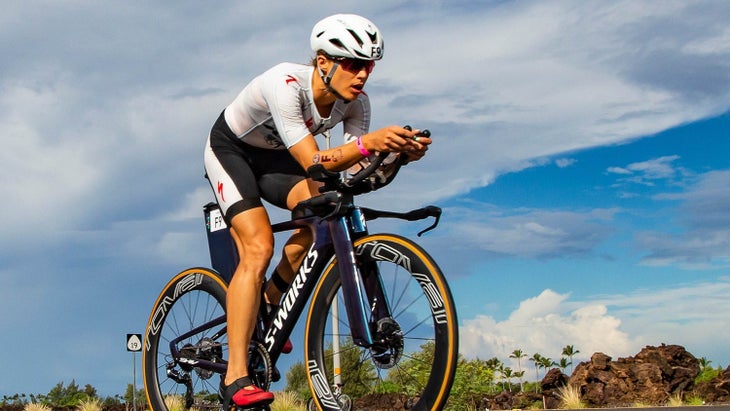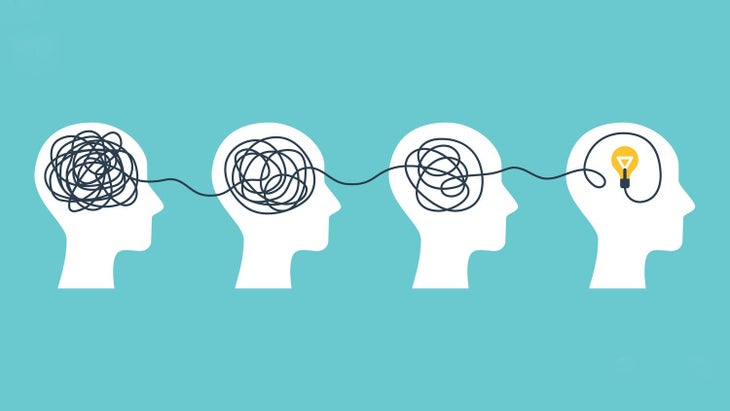Jill Colangelo was used to pain. As a runner and triathlete, the 39-year-old was proud of her ability to endure. She saw her tenacity as a superpower, giving her the ability to push through discomfort and achieve her goals. All she had to do was tune out her body’s lamentations — night sweats, random pains, and a heaviness in her legs — by reminding herself that pain was part of endurance sports. She could deal with it. She was strong.
With every day of pushing through her symptoms, though, they grew more intense. Her legs began to swell with edema. She couldn’t remember the last time she had a menstrual cycle; her best guess was five years ago. She had mood swings and insomnia, yet she was still able to get out of bed each morning ready to train. Despite the heaviness in her legs, she still laced up every day — after all, tenacity was her superpower. All of this was only serving to make her stronger. Right?
Colangelo tried to find a medical cause for her symptoms. Nothing made sense to her doctors. She was a healthy, active woman. Her diagnosis eventually came only after a lengthy, frustrating, and disheartening process of elimination: overtraining syndrome — the result of years of a “mind over matter” mentality. Her so-called superpower turned out to be not so super.
“The fact that I was able to get myself so broken down was really stunning to me,” Colangelo said. “That I could compel myself to do something to the point where I was able to ignore things like pain or any other signs of distress. I got myself to a point where I actually injured myself in a grave way. I really became kind of curious about what would drive somebody to do something like that.”
But when Colangelo tried to find resources to help with her recovery, she found few. Most doctors didn’t know what overtraining syndrome was, much less how to treat it.
“At the time, the name associated with overtraining syndrome was [ultrarunner] Geoff Roes, who was experiencing this mysterious disease,” Colangelo said. “It was this scary thing they called ‘the unknown sickness’ and all this mystical kind of stuff.”
Though a self-described back-of-the-pack runner and triathlete, Colangelo saw similarities between herself and elite athletes who talked about overtraining syndrome, both in the symptoms they experienced and the difficulty getting a diagnosis and support. Fed up with a lack of resources, Colangelo considered entering medical school at age 40 just to gain a better understanding of how the human body works. Ultimately, she wanted to develop solutions to help endurance athletes. But the more she thought about it, the more she realized she didn’t want to treat. She wanted to prevent.
“I started to see that the true way to help people here was not to be a mechanic, where I go in and fix what’s broken,” Colangelo said. “It was about what can I do to prevent, to help people see this as an issue before it happens?”
That’s when Colangelo had a lightbulb moment. She dug deeper into the reasons she trained so much in the years leading to her breakdown, and clear patterns emerged.
“I am an anxious person who felt less anxious when she could get a huge amount of running in,” Colangelo said. “I am an insecure person who found that it felt good to do this thing that everyone seemed to be impressed by. I was sad after my divorce and found that pushing the pedals of my bike made me cry less. I started to pull back the curtain and saw a lot of things in concert. I started to see how I could ignore so many things for so long.”

Running…or Running Away?
The evidence is clear that physical and mental health work in tandem. When a person begins to exercise, it sets off a cascade of reactions that benefit the brain as much as the body. As little as y can have a profoundly positive impact on depression, anxiety, and ADHD. It can also relieve stress, improve memory, and boost overall mood. If a little is good, then more is better, right? Endurance athletes, who exercise much more than 15 minutes per day, should be the picture of physical and mental health.
But Colangelo’s experience underscores how this isn’t always the case. During her recovery, Colangelo struggled to find resources geared toward endurance athletes. What was available in sport psychology journals and textbooks at the time mostly looked at factors like tenacity and perseverance. They lauded the athlete’s ability to never, ever give up, no matter what. Colangelo saw how this romanticized idea of grit and resilience allowed her to frame her self-inflicted suffering as heroic instead of what it really was—an unhealthy coping mechanism.
“I started going down the rabbit hole of origin behaviors that would lead someone to repetitive training without any kind of scruples,” Colangelo said. “And I was able to see how closely linked a person’s mental state can be to their allegiance to endurance sport, and how it can become an all-consuming lifestyle.”
She had years of anecdotal information, gathered on long bike rides where people talked about swapping alcohol or drug addiction for a triathlon hobby, or in ultrarunning Facebook groups where people stoutly asserted “running is my therapy.” Colangelo suspected mental health issues were more prevalent in the endurance community (and that unique resources were needed to help these athletes develop a healthy relationship with sport) but she could only find limited research.
The more training hours per week, the more someone is likely to have risk for mental illness.
“There were people doing research on the physiological aspects of participation in running and triathlon, but no one was asking the question of ‘Who would go out and exercise for six hours at a time?’ Like, who in the hell would do this?” Colangelo said. “I wanted a study that looked at the relationship between the number of hours per week spent training and mental health status. When I couldn’t find it, I set out to do it myself.”
Colangelo, who had earned a bachelor’s degree in psychology almost two decades prior, enrolled in graduate school to study mental health. , which compared more than 500 ultra endurance athletes to a general U.S. population, ultimately confirmed her original hypothesis. Athletes in the study consistently displayed higher risk for mental health issues like depression, anxiety, disordered eating, alcohol abuse, and suicidal thoughts. Mental illness affects 20% of the general population in the U.S., but 37% of endurance athletes reported having been diagnosed with mental illness prior to the study, and 46% showed risk factors for mental health issues. An at-risk assessment tool revealed that 24.5% of endurance athletes were at risk for alcohol use disorder—almost five times more than in the general population. Endurance athletes also displayed significantly higher risk for eating disorders comparatively in both men and women. When broken down by training volume, the data show that as time spent in training goes up, so too does the risk of a variety of mental health issues; those who trained more than 20 hours per week were at highest risk.
On the surface, it seems training would be a healthier coping mechanism. Exercise is as part of the treatment plan for mental health issues like depression and anxiety. But Colangelo’s study on ultra-endurance sports isn’t the only one that suggests too much exercise might be a red flag for mental health issues. In one from more than 1.2 million U.S. adults, subjects reported an average of almost 3.4 days of poor mental health (stress, depression, emotional problems) in the past month. Those who exercised struggled nearly 1.5 fewer days a month, a 43.2% decrease in mental health burden. That same data analysis found that people who exercise for more than six hours a week have a higher mental health burden than those who exercise three to five times a week; exercising for more than three hours at a time is associated with worse mental health than not exercising at all.
“The more training hours per week, the more someone is likely to have risk for mental illness in categories like depression, anxiety, and eating disorders,” Colangelo said. “Endurance sports tend to be a great place to hide a variety of issues. This suggests that just as many people are running away as running.”

What Is the Runner’s High?
Just about every endurance athlete has been called crazy at some point. The idea of running 26.2 miles (or 140.6, for that matter) is not how most people would describe their perfect Sunday morning. So yes, by that definition, endurance athletes could probably be colloquially described as a few tacos short of a combination platter. But having a unique hobby is not the definition of mental illness.
Mental illness refers collectively to all diagnosable mental disorders. Many people have mental health concerns from time to time, but a mental health concern becomes a mental illness when ongoing signs and symptoms cause frequent stress and affect a person’s ability to function. Training for an Ironman or ultramarathon in and of itself is not unhealthy behavior. There are plenty of reasons to do both that have nothing to do with mental health issues. There are also many who use endurance sports as a critical coping strategy for things like anxiety or depression. But planning one’s entire life around exercise, continuing to exercise with an injury, withdrawing from work, family, or social obligations to exercise, or showing withdrawal symptoms may be signs of a larger problem. Symptoms may also manifest outside of workouts, like severely restricting calories while training or being unable to sleep for weeks or months due to anxious thoughts.
Overtraining syndrome is a physical diagnosis, given when a person exercises too much and rests too little. Relative Energy Deficiency in Sport (or RED-S) refers to impaired physiological functioning caused by relative energy (calorie) deficiency. To date, however, there is no psychological equivalent. The Diagnostic and Statistical Manual of Mental Disorders (DSM-V), used by clinicians and researchers to diagnose and classify mental illness, does not include exercise addiction as a standalone diagnosis (it is only referenced once, as a criterion for diagnosing eating disorders).
That’s frustrating for researchers like of Temple University. In 1984, Sachs was one of the first to publish an article on the concept of exercise addiction (under the name “running addiction”) to describe a set of withdrawal symptoms that surface during periods when a person is not running. These withdrawal symptoms could be so intense they motivate runners to continue despite injury or other adverse consequences.
“This isn’t like a streak, where people run every day without missing a day because it’s a fun goal,” explains Sachs. “The addiction piece is really something we differentiate from a healthy habit. If you can’t run on a day you plan to run, it makes you feel guilty, irritable, anxious, nervous. Most people can miss a day here or there for family commitments or a rest day. [In addiction] you lose control over your ability to make that decision. The number-one priority is exercise, and everything else takes second place.”
The concept of addiction typically refers to an excessive and out-of-control consumption of substances like drugs or alcohol. In a way, exercise elicits a similar response. Endorphins produced by the body during exercise are converted into a peptide similar to opiate drugs, which may explain why feelings of euphoria, harmony, and a reduced perception of pain—also known as — are similar to those described by people addicted to drugs or alcohol. It also may explain why some runners experience withdrawal symptoms when they don’t run.
“That doesn’t mean that we generalize to a whole population of endurance athletes and say just because we all exercise so much, we’re addicts,” Sachs said. “Just like there are social drinkers who can have a glass of wine every evening without being affected, most runners can do their workout and then go about their day. Then there are some people who can’t function unless they have six beers or six miles, and that’s obviously not good.”
Because we’re so strong, we should be able to handle hard things and always finish what we started at any cost. Any cost.
Endurance sport culture, with its heavy training demands and constant drive to improve, can fan the flames of mental health issues like anxiety and depression. Yet a pervasive glorification of “pushing through the pain” often takes its toll on body and mind. In one study, Sachs and colleagues discovered that even though endurance athletes require some degree of mental toughness, the romanticization of pushing through the pain can have harmful consequences. Regularly encouraging athletes to exceed their perceptual or actual limitations causes them to do just that — for better and for worse.
“On one hand, doing something like an Ironman or ultramarathon takes a tremendous amount of physical capability and mental toughness. You’re out there for a long time, and you’re pushing your body. In that way, it can make us feel like we’re pretty strong,” Sachs said. “Because we’re so strong, we should be able to handle hard things and always finish what we started at any cost. Any cost.”
This toughness can also be an obstacle in seeking help. When faced with a sore knee, the typical endurance athlete will simply pretend as if everything is fine, because they have a race coming up and they can’t afford to take time off for rest or physical therapy. The same approach is often used for mental health as well, where the athlete acts as if everything is fine. They rationalize that if there is a mental health issue, exercise will surely cure it. Running is therapy, right?
“Yes and no,” Sachs said. “Exercise isn’t a panacea or cure-all. It can be a really important coping strategy for things like depression or anxiety, and for some people it can be enough. But the intensity or severity of the mental health challenge the person is facing matters. The exercise may indeed be helping somewhat, but you might need more support from an experienced clinician. Just because you train a lot doesn’t make you immune from mental health issues.”
Sachs points to recent examples of Naomi Osaka and Michael Phelps, both athletes at the top of their respective sports, who also happen to be affected by mental health issues. Olympic triathlete Sarah True about her experience with depression throughout her college, Olympic, and Ironman racing career. In recent years, runners and triathletes at every level of the sport, whether finishing at the back of the pack or the top of the podium, have shared their stories of alcoholism, drug addiction, depression, anxiety, eating disorders, and suicidal thoughts that haven’t been cured just by exercise. The fact that people are now talking about mental health in endurance communities gives Sachs hope for a brighter future.
“We can change the conversation,” Sach said. “If someone has a broken ankle, we don’t tell them to toughen up, dig deep, and plow through it. It’s not going to magically heal on its own. So why are we pretending like that’s good advice for mental health?”

The Injuries We Can’t See
One reason we have better advice for broken ankles is that we can clearly see the issue. That’s not always the case with anxiety or depression. Even disorders we think would be obvious aren’t always. anywhere between 30% to 90% of alcoholics are functional, meaning they blend into society by doing most of what one without the disease would do, like maintain jobs and relationships or even train for races — all while still meeting the criteria for alcohol use disorder.
Not being able to recognize mental health disorders is a byproduct of the way we’ve approached sport psychology in the past, said , chief medical officer of the National Collegiate Athletic Association (NCAA). If we don’t study the problem, how do we even know the problem exists? When we’ve filled the research gap with studies on grit and tenacity, it sends the message that athletes simply need to toughen up.
“It’s common for coaches to promote this sense of being tough because that’s what you have to do to win, to persevere,” Hainline said. “At events, it’s about the competition and physical fitness. Even in society, we don’t put mental health in the same place as physical health. Our insurance companies don’t allow the same access to care for mental health services as physical health.”
In recent years, Hainline has been part of a movement to prioritize mental health in multiple sport agencies, including the NCAA and the International Olympic Committee (IOC). In 2018, the IOC Medical and Scientific Commission assembled a team of international experts, including Hainline, to take a scientific approach for addressing mental health symptoms and disorders in elite athletes. The result was a groundbreaking which recommended mental health prevention and management techniques for doctors, psychiatrists, and other professionals who work with elite athletes.
“Athletes are human beings,” Hainline said. “We forget that sometimes. And as human beings, athletes suffer from mental health symptoms and disorders similar to the regular population, or for certain disorders, they have a higher rate. Even in certain sports in which your body is shown a lot, like in wrestling, beach volleyball, or swimming, the eating disorders are a lot higher as a result. That has profound mental health and other consequences.”
Athletes are human beings. We forget that sometimes.
One particular point Hainline has tried to emphasize in his work is that the responsibility for mental health should not be placed solely on the athlete. Stigma is a powerful deterrent for athletes self-identifying mental health disorders and seeking help. Mental health is already seen as a sign of weakness, but more so in sporting environments. Individual and cultural factors can also make athletes reluctant to seek help for mental health issues. In , Hainline and colleagues found elite athletes who were from underrepresented groups, such as women, people of color, or para-athletes, particularly struggled to reach out.
“There’s that stigma out there,” Hainline said. “Not just the stigma of mental health disorders, but the stigma that they believe they’re already abnormal. There’s a dual stigma, and that can be devastating.”
To remedy this, Hainline has pushed for a new approach to mental health in sport, where every person who comes into contact with an athlete, whether coaches, physical trainers, or athletic directors, knows how to recognize and address mental health issues. This involves a certain degree of deprogramming decades of a mind-over-matter mentality. To accomplish this, he relied on the data.
“Really good coaches, when you get to know them, they love data,” Hainline said. “They say show me the evidence, and we do. The data are becoming clear that mental health symptoms, and especially mental health disorders, can predict injury. If you’re injured and develop depression or anxiety after injury, it predicts poor recovery. Sleep deprivation not only predicts poor performance, but it predicts depression and other mental health disorders.”
His pitch builds out into a broader umbrella of periodization, showing evidence that training hard without appropriate recovery predicts the development of mental health symptoms and disorders. His final line — a reminder that athletes are human beings — is an impassioned plea for a holistic approach to coaching. His ultimate goal is for all sport programs, whether at the amateur or elite levels, to be able to spot the warning signs of mental health issues, have a well-rehearsed plan for routine and emergency mental health issues in athletes, develop a well-rooted network to refer athletes to appropriate resources, and a clear message to athletes that they won’t be penalized for seeking help.
“If you do that, you’re going to have a better human being with better performance,” Hainline said. “In the training process, we’re usually thinking about the end game of winning a medal. We’re not thinking about the developmental game, that every time I’m doing this as an athlete, I’m actually a human being. This athletic journey is part of who I am as a human being, but me as a human being is not the athletic journey. So the real issue is that we define ourselves by the medals, or by being the athlete, rather than defining ourselves as a soulful human being and the athletic experience as one part of that.”

Changing the Conversation
Though Hainline’s framework for mental health was developed for elite athletes, many of the lessons apply to everyday endurance enthusiasts, who (like elite athletes) often see their pursuits as a lifestyle, not a hobby. A healthy endurance community requires input at all levels, from the athletes themselves to the professionals who work with them.
hopes to use new evidence on mental health in endurance sports to launch additional research on athletes as well as develop a screening tool for medical and mental health professionals, starting with one question: How many hours per week do you exercise?
“Currently, doctors tend to have a monolithic view of exercise. They say ‘Are you doing it? Yes? Great,’” Colangelo said. “But they rarely consider what high volumes of training could reveal about physical and mental health.”
This doesn’t mean doctors would suddenly become experts in Ironman training or ultrarunning, nor would it mean someone who trains 20 hours per week would automatically be prescribed antidepressants. It would simply be one more tool available to medical professionals to assess a patient and start a conversation about mental health. Colangelo offers up the screening protocol currently used for alcohol as an example. During a routine check-up, healthcare professionals ask how many drinks per week a person consumes. Two glasses of wine per week will yield a different response than twenty; a larger number may signal the patient is using alcohol to self-medicate anxiety or depression.
Colangelo says the same can be applied to exercise. Asking the simple question of “How much are you exercising?” could be an effective screening tool to begin conversations about mental health as well as physiological complications like overtraining syndrome or . “In my research, there was a big gap between the number of endurance athletes at risk for mental health issues and the number of people who actually had a diagnosis, meaning there are quite a few people out there experiencing symptoms of everything from alcohol abuse to panic attacks to disordered eating, and have not had mental health care. This was particularly true for men, who were more likely than women to be undiagnosed.”
Sachs, a lifelong runner, would like to see exercise addiction included in diagnostic materials for mental health practitioners. He’d also like to see endurance sports leverage the power of community to change the way athletes and coaches talk about mental health. “One of the great things about endurance sports is that there’s a wonderful community of extremely supportive individuals. If someone is walking with a limp, we’re quick to ask that person what’s the matter or how can we help. From a mental health standpoint, we can ask, ‘Are you OK?’ when something doesn’t seem quite right. We can refer people to professionals who might be helpful.”
Colangelo agrees that normalizing mental health conversations in ultra-endurance sports is a powerful step to showing that physical fitness isn’t the only indicator of health.
“We assume that if someone can run an ultramarathon or bike a century, they must be okay,” Colangelo said. “Because of that, many endurance athletes think they are the only one experiencing these pains, whether it’s with alcohol, anxiety, disordered eating, or even suicidal thoughts. The more we can let people know they are not alone, the better.”
In time, experts hope the stigma of mental health is removed and replaced with a message of strength. This is where endurance athletes may particularly excel, says Sachs:
“The good news? We endurance athletes have a lot of experience dealing with challenges, and because of this, athletes facing mental health issues may very well be more likely to be successful in dealing with this challenge. But it’s not necessarily something you can do on your own. The fact that you may have mental health issues doesn’t diminish your qualities as a person or your ability to be an excellent athlete. It just means you’ve got another challenge to take on.”
.
—


